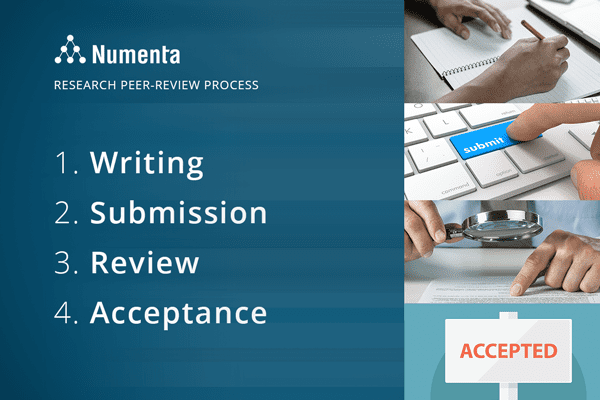I’ve spent the past 4 years here at Numenta working on developing and designing example applications and websites related to our Machine Intelligence technology. This continues my long career path of developing software products and user experiences. But, here at Numenta, I had the wonderful opportunity to experience something new: serious, cutting-edge scientific research.
For almost a decade, this small Numenta team has been developing a working theory of how intelligence is realized by the human brain. Hierarchical Temporal Memory (HTM) is our theory of how neurons and the architecture of the neocortex produce real-time learning, pattern detection and prediction, and ground-breaking anomaly detection. During this time we have been focused heavily on research, theory, and software development. You can now run HTM on your own computer with our open-source machine learning library, NuPIC (the Numenta Platform for Intelligent Computing), or try out one of our intelligent example applications like HTM Studio.
Last year we felt that it was important to communicate our theories and engage in a dialog with the scientific community. As such, we decided to submit our research for peer-review, and to publish our work in major neuroscience-related journals. We have been looking forward to this milestone for a long time, as have many of our partners, customers, developers, and friends. Our new Research Papers page showcases the results of our work in this area. Here you can find new peer-reviewed published content, conference papers and posters, and academic pre-print links (such as arXiv and bioRxiv).
What does it take to get a modern scientific paper peer-reviewed, and published in a journal? I was very curious about how this process worked when I started at Numenta. I had read many peer-reviewed articles before, but had never been on the other side of the process. In order to find out, I’ve been observing Numenta’s Research team in action, taking notes, and performing interviews.
Our process, which is fairly standard in academia, follows four general steps which are detailed below: Writing, Submission, Review, and Acceptance.

Step 1 – Writing
The writing process starts with researching a topic, such as how the neocortex learns sequences of patterns. As the topic is selected, the author will also explore where they may want to eventually publish their new work: in a peer-reviewed journal, at a conference poster session, on a pre-print server, or even as a simple blog post. When considering journals, in line with our open research policy, we have decided to publish only in those journals that offer free open access to papers.
The hardest part of the entire process, the writing, begins in earnest. Outlines and drafts are produced, which are reviewed with plenty of constructive feedback. For a serious scientific paper, the author must perform careful rounds of “Literature Research” in order to understand and report on what previous authors have published on the same topic. This helps prevent wasted effort, and can keep focus on unexplored subtopics.
After many heavy rounds of iteration, the text begins to solidify. Visual charts and diagrams, even example source code, (“Simulations”), are added to support the paper. As the new document is nearing completion, it will pass through final rounds of internal review and revision, and finally, “Internal Acceptance”.
Step 2 – Submission
The author will submit the new paper to the publishing targets they selected earlier. In modern times, this means creating website accounts to get access to the publisher’s online tools.
The new paper must be put into a high-quality format, as per specifications from the publisher. All documents, text, and imagery are uploaded to the submission website. The author must enter metadata about their new document, such as paper title, description, keywords, and other helpful details.
A unique cover letter is sent with the upload, informing the publishing Editor of the seminal nature of the work, along with any time-sensitive requirements. The author suggests peers who would both be preferred, and not preferred, to perform the review (it is up to the Editor to decide whether to take this advice). The author also declares any conflicts of interest that relate to the paper, peers, or topic.
Once the final upload is submitted, the Publisher will validate that everything is complete. Then, the waiting begins. It can take several months for the Publisher to fully process your submission. Eventually, the Publisher will reply with either a negative “Reject” or positive “Review” response. (For a pre-print server like arXiv, there is no further review, and this is the end of the process.)
Step 3 – Review
It’s a wonderful accomplishment to be accepted for Review, but now the work is just getting started. The peer reviewers will often suggest changes to your paper, requiring rewriting and resubmission. This iterative cycle is may be repeated several times.
This can be a frustrating stage, involving empty periods of waiting, alternating with busy periods of deep, rapid change, lasting in total for several months or sometimes even a year.
Step 4 – Acceptance
Eventually, the author, reviewers, and publisher will agree that the paper is finished. The author validates a “Final Proof” which is uploaded to the publisher. This document is what is used in the final reproduction. Lastly, a final publishing fee is paid online, and the publisher accepts the paper.
Depending on the publisher, a few weeks to months later, the final paper will be released. After what has likely been more than a year of work, the authors and team can share the results of labor with the world.
Having our research reviewed and published by our peers is a great accomplishment for us. It can be a long and difficult process. But, with lots of hard work, steady perseverance, and a little luck, we have found the results to be well worth the effort. We hope that you will too.
As always, our theory and research are open to the community, so we hope that you’ll join us in our progress. Thanks for reading about research at Numenta.
